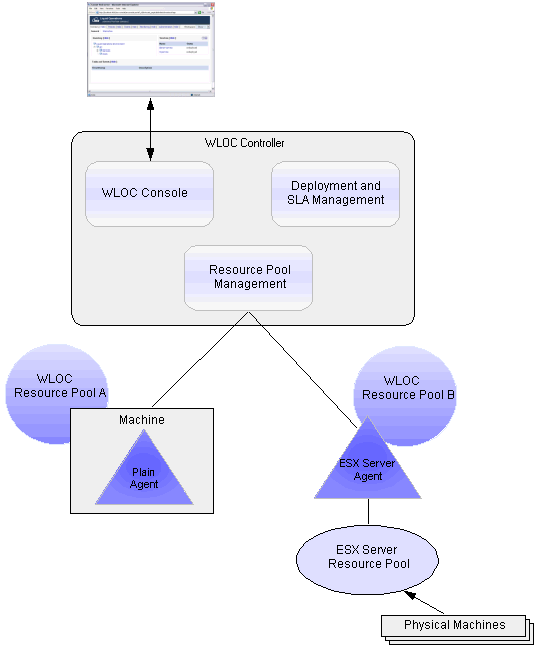







|
This section provides an overview of WLOC with respect to the configuration tasks explained in this document.
A WLOC environment consists of the following components:
The Controller is the central component that gathers data about the operating environment from Agents. It uses the gathered data to enforce policies and to deploy new services in order to honor the Service Level Agreements (SLAs) of all deployed services. The Controller hosts the WLOC Administration Console.
WLOC Agents provide information about the environment to the Controller, start and stop processes, and invoke other actions at the Controller’s request. A plain agent gathers data and manages processes on a single physical machine. An ESX Agent communicates with the VMware Virtual Center to gather data about the VMware resource pools in order to manage LiquidVM instances.
Configuration tasks associated with Java processes includes service definitions, instructions for starting and stopping processes, and managing policies that govern service deployment and adaptive actions that ensure compliance with service requirements.
Figure 2-1 provides a high-level view of the relationship of WLOC components.

Configuration tasks can be considered of three types:
A Controller configuration defines information used to start the Controller, connect to WLOC Agents, capture event logs, and notification methods to use when policy definitions are not being met by the managed application.
A WLOC agent configuration consists of its operational settings (address, connection ports, log level, etc.) and information about its managed resource pool (CPU cycles, memory, and IP addresses).
This section provides a high-level and logical description of the configuration tasks described in this document.
This involves installing the WLOC Controller and creating the Controller instance with initial configuration. For instructions on configuring a Controller, see Configuring a Controller. In addition, instructions on performing silent mode Controller configurations are located in Appendix A.
This includes starting the WLOC Controller and Agent(s) and accessing the WLOC Administration Console. This information is found in Starting and Stopping the Controller and Agents.
This includes setting up WLOC services under management and defining the service’s initial deployment requirements are described in Configuring Services.
This includes defining adaptive runtime policies to ensure service requirements are being met. For detailed information, see Defining Policies.
This includes securing access to WLOC and configuring secure communications between WLOC components and managed processes. Information about securing access to WLOC is contained in Configuring Security. In addition, achieving secure communication between WLOC components is an essential part of Controller and Agent configurations.
To ensure SLAs are being met, the runtime behavior of the managed applications are monitored to determine if additional policies are needed or existing policies require refinement. For information, see Logging, Auditing, and Monitoring.


|